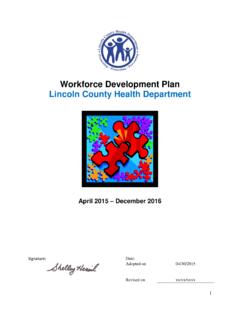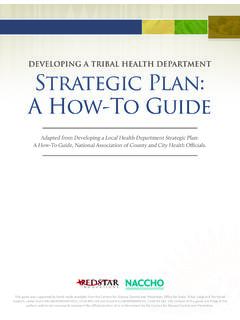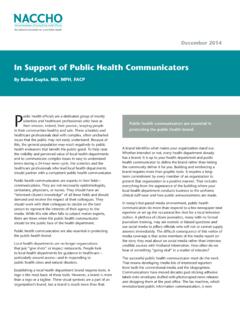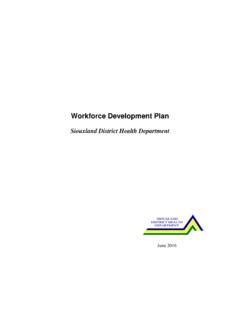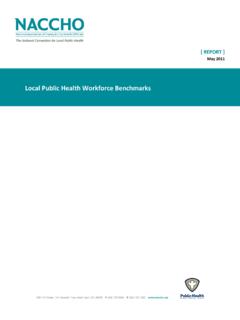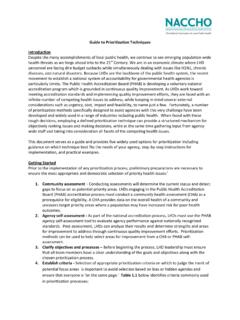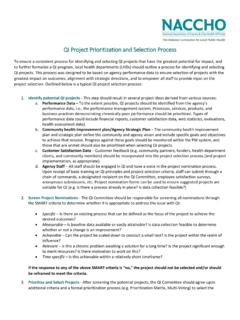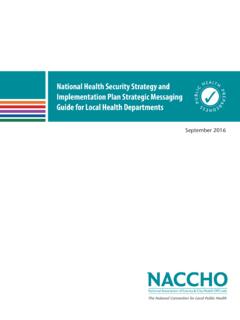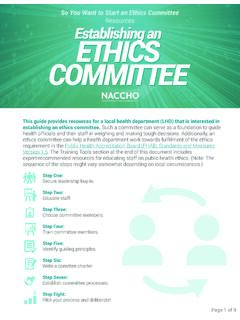Transcription of Developing a Local Health Department Strategic Plan: A How ...
1 Developing a Local Health Department Strategic Plan: A How-To GuideWith support from the Robert Wood Johnson Foundation, this guide was prepared for NACCHO by the Illinois Public Health Institute2 Developing a Local Health Department Strategic Plan: A How-To GuideTable of ContentsIntroduction ..3 Module I: Exploring Strategic Planning for Local Health Departments ..6 Module II: Laying the Groundwork for Strategic Planning ..16 Module III: Developing Mission, Vision and Values ..23 Module IV: Compiling Relevant Information: Environmental Scan ..37 Module V: Analyzing Results and Selecting Strategic Priorities ..42 Module VI: Developing the Strategic Plan and Implementation Plan ..49 Module VII: Implementing, Monitoring and Revising as Needed ..59 Appendix ..663 Developing a Local Health Department Strategic Plan: A How-To GuideIntroductionAn organizational Strategic plan provides a Local Health Department (LHD) and its stakeholders with a clear picture of where it is headed, what it plans to achieve, the methods by which it will succeed and the measures to monitor progress.
2 Widely used by profit-based, nonprofit and governmental organizations alike, a Strategic plan is a leadership tool grounded in decisions the organization has made about Strategic priorities for the near future - usually the next three to five The plan not only communicates these priorities, but also provides a basis for future decision-making. The Strategic plan is not intended to be a stand-alone document; rather, it should be aligned with other important assessment, planning and evaluation work such as a Local community Health improvement process, an agency quality improvement (QI) plan, operational/work plans or even an annual report. A Strategic plan is so fundamental to effective management that it is one of three prerequisites for LHDs seeking national, voluntary accreditation through the Public Health Accreditation Board (PHAB), the national accrediting body for Tribal, state, Local , and territorial public Health departments.
3 Since PHAB s launch in the fall of 2011, a growing number of LHDs have expressed interest in pursuing accreditation, and thus need to develop a Strategic plan. 1 PHAB measure requires a Strategic plan dated within the last five Developing a Local Health Department Strategic Plan: A How-To GuideAbout this GuideNACCHO recognizes the need to provide capacity-building resources for LHDs interested in Developing a Strategic plan, and offers this guide as a tool to LHDs as they begin the journey. Additional accreditation resources are available on the NACCHO website at the following URL: This guide is intended for any LHD interested in embarking on Strategic planning, especially those interested in Developing a Strategic plan that meets PHAB requirements. The guide provides a basic framework for Developing a Strategic plan, including the most commonly found elements in various Strategic planning models as well as the components required by PHAB for a Strategic plan as outlined in the PHAB Standards and Measures Version , Standard While the guide addresses all the PHAB required components of a Strategic plan, PHAB is the only organization to determine if the Strategic plan meets their requirements.
4 Following this guide does not guarantee that PHAB reviewers will deem a Strategic plan compliant with the standards and measures. In addition, there are many ways to complete a Strategic plan, this guide outlines one such way. The guide includes seven learning modules, which provide an overview of the Strategic planning components, rationale and process descriptions, suggested options for completion, and accompanying samples and worksheets. The Guide follows the Strategic planning process with a module dedicated to each of the major steps below. 5 Developing a Local Health Department Strategic Plan: A How-To GuideThe Strategic Planning Process as outlined in this guide: Module II: Laying the Groundwork for Strategic Planning Identifying and Defining Stakeholders Determining Available Data Developing Process and Timeline Needs Developing a Project Plan Module III: Developing Mission, Vision and Values Identifying Formal and Informal Organizational Mandates Determining the Type and Level of Stakeholder Engagement Developing Organizational Values Statements Developing Mission Statement Developing Vision Statement Communicating Vision, Mission and Values Module IV: Compiling Relevant Information: Environmental Scan Determining Value of Existing Data Collecting Additional Data/Information as Needed Summarizing Data/Information Module V.
5 Analyzing Results and Selecting Strategic Priorities Completing a SWOT/SWOC Analysis Identifying and Framing Cross-cutting Themes, Emerging Issues and Key Strategic Issues Prioritizing and selecting Strategic Issues Module VI: Developing the Strategic Plan and Implementation Plan Developing Strategies to Address Priorities Developing Goals and Objectives Developing Strategic Implementation Plan with Timelines and Measurement Plans Creating a Strategic Planning Document Module VII: Implementing, Monitoring and Revising as Needed Establishing a Process for Monitoring, Implementation and Evaluation Using QI to Improve Process and Outcomes Maintaining Flexibility Communicating Results Revising and Updating the Plan as Needed6 Developing a Local Health Department Strategic Plan: A How-To GuideLearning GoalDetermine when the agency will be ready to embark on Strategic planning, including identifying any steps needed to increase Describe the purpose and use of an agency Strategic Define the PHAB requirements for a Strategic Identify the key components of a Strategic planning process and a Strategic Assess readiness for Strategic planning based on guidance and I: EXPLORING Strategic PLANNING FOR Local Health DEPARTMENTS Purpose and Use of an Agency Strategic PlanThis module provides essential information regarding Strategic planning as LHDs determine their interest and readiness to embark on such a process.
6 This module serves as an introduction to the next six modules, which outline the steps in a Strategic planning a road map, a Strategic plan indicates an agency s current position and the directions the agency can follow to achieve its goals. The plan also provides criteria for monitoring the progress and outcome of the plan. A Strategic plan can make decision-making and change easier for an organization, as it defines the organization s identity and goals while providing clear direction for achieving these goals. However, because an organization needs to remain nimble and adapt to changing environments and needs, the Strategic plan must also remain flexible and of a Strategic Plan (PHAB Acronyms and Glossary of Terms, Version , September 2011)A Strategic plan results from a deliberate decision-making process and defines where an organization is going. The plan sets the direction for the organization and, through a common understanding of the mission, vision, goals and objectives, provides a template for all employees and stakeholders to make decisions that move the organization forward.
7 (Swayne, Duncan, and Ginter. Strategic Management of Health Care Organizations. Jossey Bass. New Jersey. 2008).7 Developing a Local Health Department Strategic Plan: A How-To GuideThe five P s of strategy (Mintzberg, 1992):Plan Strategy is a planned and purposeful course of intended actions or guidelines for how to get from one place to Strategy is a pattern or consistency in actions and behavior over Strategy is position within the context and environment in which the organization Strategy is collective thinking and shared vision/direction by members of the Strategy can also be a specific maneuver to outwit or overcome a competitor or enemy. Although Strategic planning also involves goal setting, it is broader in scope and much more comprehensive than opera-tional planning. (Martinelli, 2005) To understand the difference between a Strategic plan and an operational plan, consider Mintzberg s 5 P s of Strategy.
8 Each of the 5 P s describes a different approach to strategy. The framework helps to ensure data and information are addressed in all areas as Strategic planning begins and is a way to cross-check plans to ensure all angles of Strategic planning are M. Bryson s (2004) third edition of Strategic Planning for Public and Nonprofit Organizations, offers a clear view of Strategic planning in the diagram The ABCs of Strategic Planning. Understanding where the organization is in terms of context, environment and budget (A) is necessary for the organization to define both where it wants to be, through vision, mission, and goals (C), and the strategy by which the organization will get there (B). This transformational model may appear simplistic, but it involves many interdependent steps and opportunities for stakeholder engagement throughout the process. A Where You AreMission andMandatesStructure and SystemsCommunicationsPrograms and ServicesBudgetSupportB How to Get ThereStrategic PlanIT and HR PlansCommunicationsHiring and TrainingRestructuring and ReengineeringBudget AllocationsC Where You Want To BeMission and MandatesStructure and SystemsCommunicationsPrograms and ServicesBudgetSupportVision, Mission, and GoalsStrategy ImplementationStrategy FormulationStrategicIssues8 Developing a Local Health Department Strategic Plan: A How-To GuidePHAB Requirements for Strategic PlanningFor a Health Department to be eligible for PHAB accreditation, they must first complete the following three prerequisites: 1).
9 Community Health Assessment (CHA); 2). Community Health Improvement Plan (CHIP); and 3). Agency Strategic Plan. The prerequisites for accreditation lay the groundwork for everything a Health Department does and provides a foundation for meeting the PHAB standards and measures. Each of the prerequisites is defined in the PHAB Acronyms and Glossary of Terms, Version as listed below: Community Health Assessment A systematic examination of the Health status indicators for a given population that is used to identify key problems and assets in a community. The ultimate goal of a CHA is to develop strategies to address the community s Health needs and identified issues. Community engagement and collaborative participation are essential to conducting a CHA. Community Health Improvement Plan A long-term, systematic effort to address public Health problems based on the results of community Health assessment activities and the community Health improvement process.
10 This plan is used by Health and other governmental education and human service agencies, in collaboration with community partners, to set priorities and coordinate and target resources. A CHIP is critical for Developing policies and defining actions to target efforts that promote Health . It should define the vision for the Health of the community through a collaborative process and should address the gamut of strengths, weaknesses, challenges and opportunities that exist in the community to improve the Health status of that community. Strategic Plan Results from a deliberate decision-making process and defines where an organization is going. The plan sets the direction for the organization and, through a common understanding of the mission, vision, goals and objectives, provides a template for all employees and stakeholders to make decisions that move the organization forward. Connecting the Prerequisites for AccreditationIt is important to remember that the CHA, CHIP and agency Strategic plan are not three discrete or isolated processes but rather, they should all connect and inform one another.
